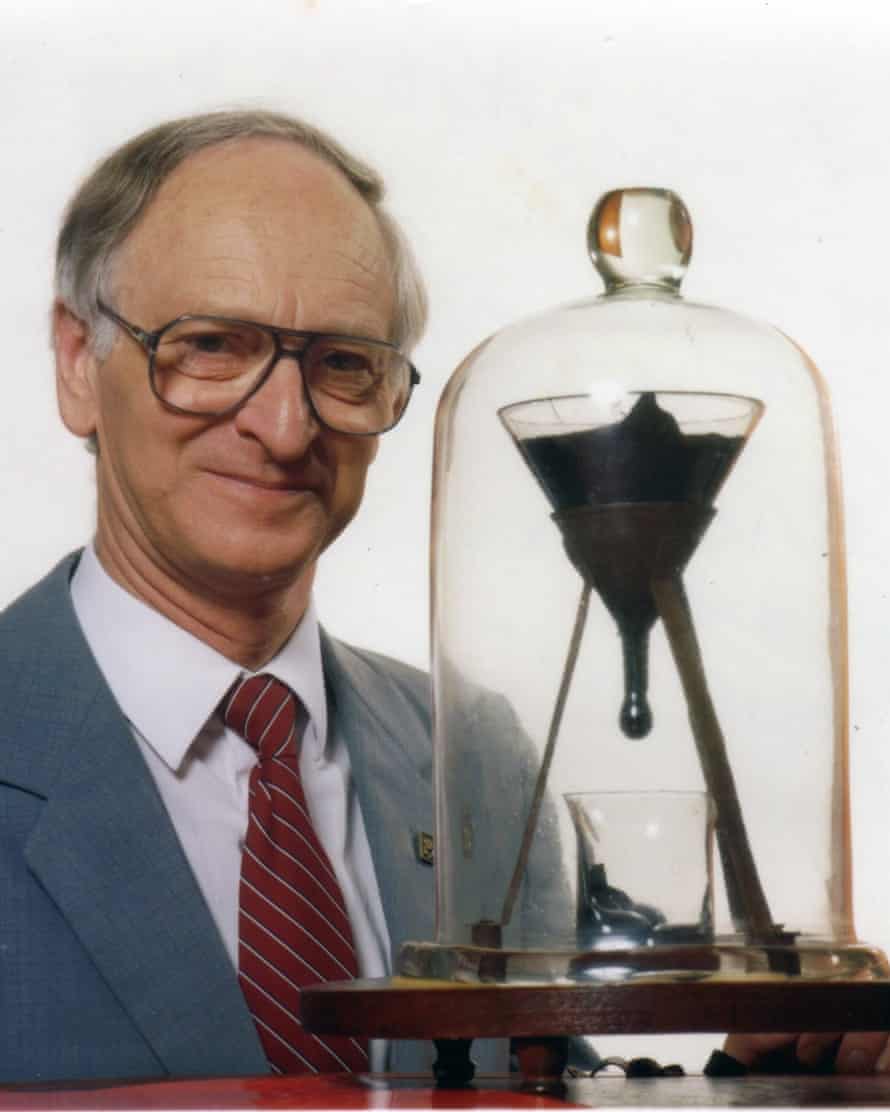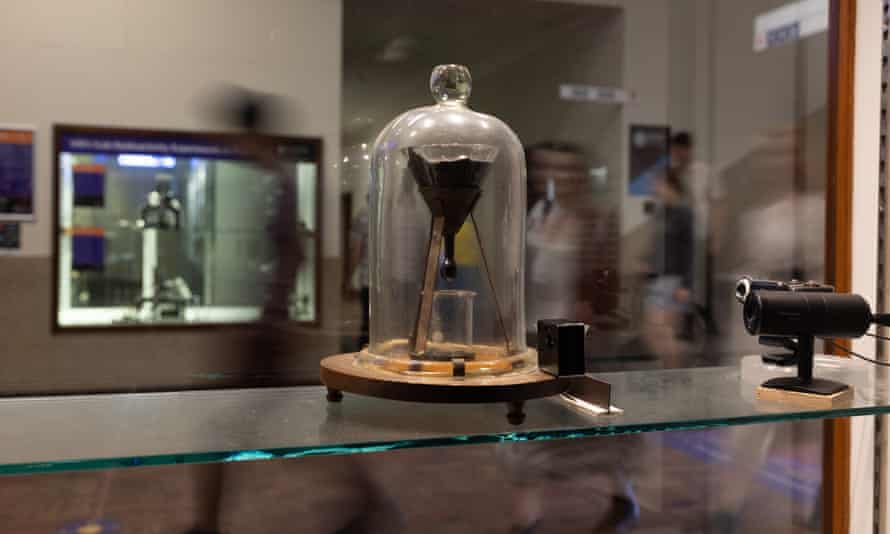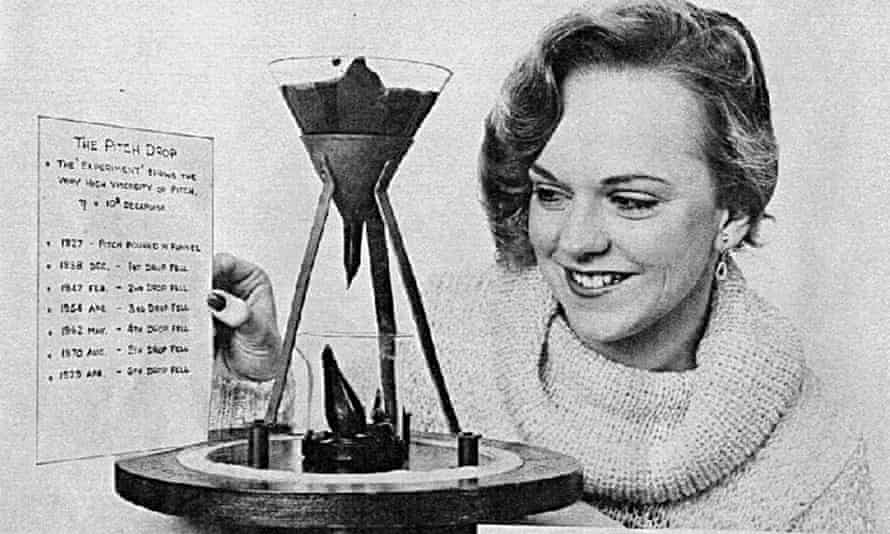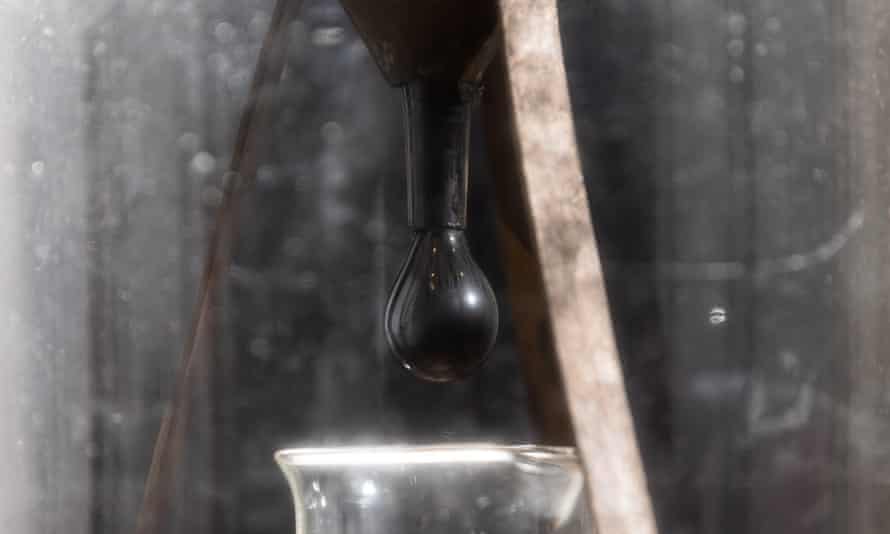On a Friday afternoon in April 1979, John Mainstone, a physics professor at the University of Queensland, rang his wife at home. He wouldn’t be back that evening, he told her. For the previous 18 years, Mainstone had looked after the pitch drop experiment, a long-form demonstration of the extreme viscosity of pitch. For the first time since August 1970, the pitch was about to drip from its funnel, and Mainstone didn’t want to miss it.
Pitch is a resin – a viscoelastic substance derived from petroleum or coal tar, used in bitumen, and for waterproofing. Which is ironic, for as solid as it appears, pitch is fluid: at least, it is when you put it in a funnel, the sloping sides of which create a pressure gradient.
Mainstone stayed up all that Friday night. He continued to keep watch on the Saturday, eventually ringing his wife back to tell her he wouldn’t be home that night, either. Still, the globule of (literally) pitch-black liquid hung by a thread from the bottom of its funnel. On Sunday evening, exhausted by his vigil, he went home. By the time he returned to work on a sleep-deprived Monday morning, the pitch had dropped into its beaker.

The pitch drop experiment was first set up by Mainstone’s predecessor Thomas Parnell in 1927. Parnell heated and liquefied some pitch, poured it into a sealed funnel, and set it over the beaker inside a large bell jar. In 1930, he cut the stem of the funnel – and waited.
Nearly a century later, the original experiment – which has become the longest running laboratory experiment in the world – stands in the foyer of the physics building in the Great Court. The jar is set inside a protective plastic cube, with an analogue Casio desk clock observing each moment as students and staff wander past. The funnel is held aloft by a brass tripod; at the bottom, a shiny black balloon of pitch hovers above the empty beaker.
It was Mainstone, taking the experiment on in 1961, who brought the pitch drop to popular attention. He also mentored its third and current custodian, Professor Andrew White, who has watched over it since Mainstone’s death in 2013. Like Parnell, Mainstone died without ever seeing a single drop fall. “I am in no way filling John’s shoes,” White insists. “He was the heart and soul of this.”
Mainstone’s dedication was legendary. In 2005, he and (posthumously) Parnell were awarded the Ig Nobel prize – a satirical award noting arcane and trivial achievements in scientific research. The Ig Nobel prize aims to honour work that makes people laugh, but also makes them think.

Author Nick Earls first encountered the experiment as a medical student at UQ in the early 1980s, later writing about it in his novel Perfect Skin. “It was a demonstration that all is not necessarily as it seems,” he says. “There is pitch – something that goes into the making of roads, something we think of as totally solid – and it turns out it’s not. It’s just 230bn times more viscous than water, and it flows, albeit very slowly.”
How slowly? “Far slower than grass growing, far slower than paint drying,” White says, mock-offended by such banal comparisons (and the suggestion that this could be, well, a rather dull experiment to watch). “We’re talking more than 10 times slower than continental drift!”
Sign up to receive the top stories from Guardian Australia every morning
He directs my attention to the joining of four tiles on the floor. “Those tiles are moving north at 68 millimetres a year, because Australia is moving north at 68 millimetres a year. It’s one of the fastest continents, as far as continental drift goes. The pitch drop is moving at least 10 times slower than that! So it’s literally slower than watching Australia drift north, and people log in live on the internet to watch it. Which I find really fascinating.”
It’s true. More than 35,000 people in 160 countries are sweating on the 10th drop of pitch. They’ll be waiting a while yet. Since Parnell cut the stem of the funnel in 1930, just nine drops have fallen: in December 1938, February 1947, April 1954, May 1962, August 1970, April 1979, July 1988 (when it became a popular exhibit at Brisbane’s generation-defining Expo 1988), November 2000 and April 2014.

White prefers to call the pitch drop a demonstration, rather than an experiment, as it has never been controlled, and thus has been subject to environmental fluctuations. For its first 30 years, it sat in a cool dark cupboard. Mainstone put it on display, and the pitch maintained its average of one drop every eight years until, in the 80s, the physics building (which is named after Parnell) was air-conditioned, which blew it out to every 13 years or so.
Sometimes, the sensitivity of the pitch to environmental conditions was forgotten. “At one stage, someone swapped the fluorescent lights above the display, which were very cool, to halogens, which are very hot,” White says, shaking his head. “No one asked anyone to change it, it was just done, and I realised that the pitch – which is normally at room temperature – was sitting at 60 degrees. The halogens are about 120, so it was flowing like a tap.”
And yet, to this day, no one has seen a drop fall. Not at Expo (White: “There were four or five people watching it, it was a hot day, I think they went out for five minutes to get some cordial”), not even when a live stream was first set up for the millennial event in 2000. Mainstone was watching from London at the time. On that occasion a classic Brisbane thunderstorm disrupted the power supply, cutting the lights and camera feed.

Mainstone died of a stroke in 2013. In a cruel twist, the last drop fell in April 2014, a few months after his death. Except, it didn’t technically drop. It just sort of oozed into the eight drops that had already fallen and solidified in the small beaker sitting under the funnel in a bell jar, without breaking away. Reluctantly, White swapped the beaker over, managing to source an old imperial-measurement model to match the original.
Since then, the beaker has sat in place – clean, empty, yet to be blackened by a single drop of goo. The lights have been replaced with LEDs. “We had a very fresh start,” White says. “And so, when anyone asks me when it will drop, I can genuinely say that I have no idea. Because the conditions have changed, as they have throughout most of the last 95 years. It’s never been kept constant.”
Just a few meters below the pitch drop experiment is a basement dedicated to quantum technology. There, White says, a lab makes pulses of light that are one hundred million billionth of a second long. And here in front of us, he says proudly, “we have something that has an event every 10 to 20 years! It really captures the different timescales of the physical world around us.”
He looks at the funnel. There is still quite a bit of pitch in there. The experiment, he says, will long outlive all of us. “Quantum mechanics is as far as you can get from bits of coal that have been heated up and are slowly pouring through a glass tube as you can get,” he says. “I am glad that we got a new beaker in there, that will be good for another 100 years or so. Two, three keepers from now, it’ll be their problem what to do next.”